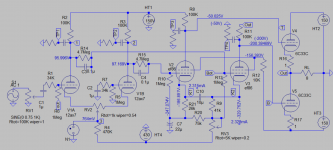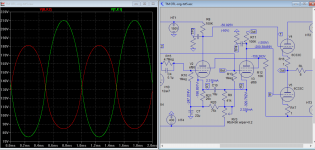I will test the EF86 tubes and cap's and replace the 1K resistors.
Btw.. the 1K resisors are 1W metalfilm.
Thanks....
Btw.. the 1K resisors are 1W metalfilm.
Thanks....

please check the one ef86 driving the 6c33 on the negative rail...
one ef86 has 150 volts plate while the other 250 volts,
so in my next build i am eyeing pentodes with 300+ volts plate ratings....
one ef86 has 150 volts plate while the other 250 volts,
so in my next build i am eyeing pentodes with 300+ volts plate ratings....
The fuse on the negative rail blow..
I use Philips EF86 tubes.
QED....I was using Mullard NOS, but one failed and the fuse blow on negativ rail.
Sometimes NOS tubes have such isues. That's why I decieded to burn and runn the valves several weeks and the check again and match.
I have bought a few E80F's and now I prefer the EF86 for sure. Seems to have more detail, and just a better soud to my ears....Maybe the E80F can be a good replacement ?, specs are better 🙄
6J32P. The Svetlana NOS are excellent.I have bought a few E80F's and now I prefer the EF86 for sure. Seems to have more detail, and just a better soud to my ears....
My oppinion is that Tim's project is perfect as it is. Nevertheless, I tried several improvement, but only feu were succesfull. FET CCS instad of R7 was one of them as well as separating the power supplyes (eg. +/-150V; +146V; -460V; )
The EF86 IMO is a poor driver tube in general and its a bit mysterious to me why this tube is being used as such. Good ones are expensive, and they are not going to hold up if things go south with the power tube.
I think a better choice might be a small power pentode, since the gain is needed and the tube has to be robust. The 6AQ5 might do the job quite nicely and is far more likely to survive the voltages and currents that are required in a driver circuit!
The EF86 is a voltage amplifier that is commonly used in lower voltage settings- such as in the preamps of my Neumann microphones. I've never seen a circuit that subjects them to much voltage- the TM OTL puts them right on the edge.
So you might think about rewiring for the pin base of a common power pentode. 6AQ5s are cheap; 3 or 4 dollars on ebay.
EL84s are bit more expensive, but have the advantage of using the same 9-pin miniature socket, so might be easier to use.
I think a better choice might be a small power pentode, since the gain is needed and the tube has to be robust. The 6AQ5 might do the job quite nicely and is far more likely to survive the voltages and currents that are required in a driver circuit!
The EF86 is a voltage amplifier that is commonly used in lower voltage settings- such as in the preamps of my Neumann microphones. I've never seen a circuit that subjects them to much voltage- the TM OTL puts them right on the edge.
So you might think about rewiring for the pin base of a common power pentode. 6AQ5s are cheap; 3 or 4 dollars on ebay.
EL84s are bit more expensive, but have the advantage of using the same 9-pin miniature socket, so might be easier to use.
The EF86 is a voltage amplifier that is commonly used in lower voltage settings- such as in the preamps of my Neumann microphones. I've never seen a circuit that subjects them to much voltage- the TM OTL puts them right on the edge.
yes, atmasphere, i was thinking that way too....
Peter Millette tested pentodes....High Gm driver pentodes
been eying that as an improvement measure...
since one plate sits at 250 volts and the other at 150 volts, i am thinking
using 2 x 47v 5 watt zeners in series shunted by 0.22ufd to lower the plate voltage
so that they sit at approximately the same plate voltage....
not sure this is a good idea though....
i am incorporating this feature in my next build and will use a jumper
pins to put this feature in or out as an experiment....
then i will decide if the jumper pins remain jumpered or not...
My oppinion is that Tim's project is perfect as it is. Nevertheless, I tried several improvement, but only feu were succesfull. FET CCS instad of R7 was one of them as well as separating the power supplyes (eg. +/-150V; +146V; -460V; )
CCS is on top of my to do list as well....
watch this #634
yes, seen that too.....but what i have in mind are cascoded
depletion mosfet CCS....
Garry Pim is the man....
yes, atmasphere, i was thinking that way too....
Peter Millette tested pentodes....High Gm driver pentodes
been eying that as an improvement measure...
since one plate sits at 250 volts and the other at 150 volts, i am thinking
using 2 x 47v 5 watt zeners in series shunted by 0.22ufd to lower the plate voltage
so that they sit at approximately the same plate voltage....
not sure this is a good idea though....
i am incorporating this feature in my next build and will use a jumper
pins to put this feature in or out as an experiment....
then i will decide if the jumper pins remain jumpered or not...
Level drops of two points in a single LTP is not easy without compromising the operating points, that is one too high and the other too low. It's necessary to lower the negative supply on the high side, here I have made them almost equal. The distortion is lower somewhat, Let me know what you think.
Attachments
- Home
- Amplifiers
- Tubes / Valves
- New Tim Mellows OTL project

